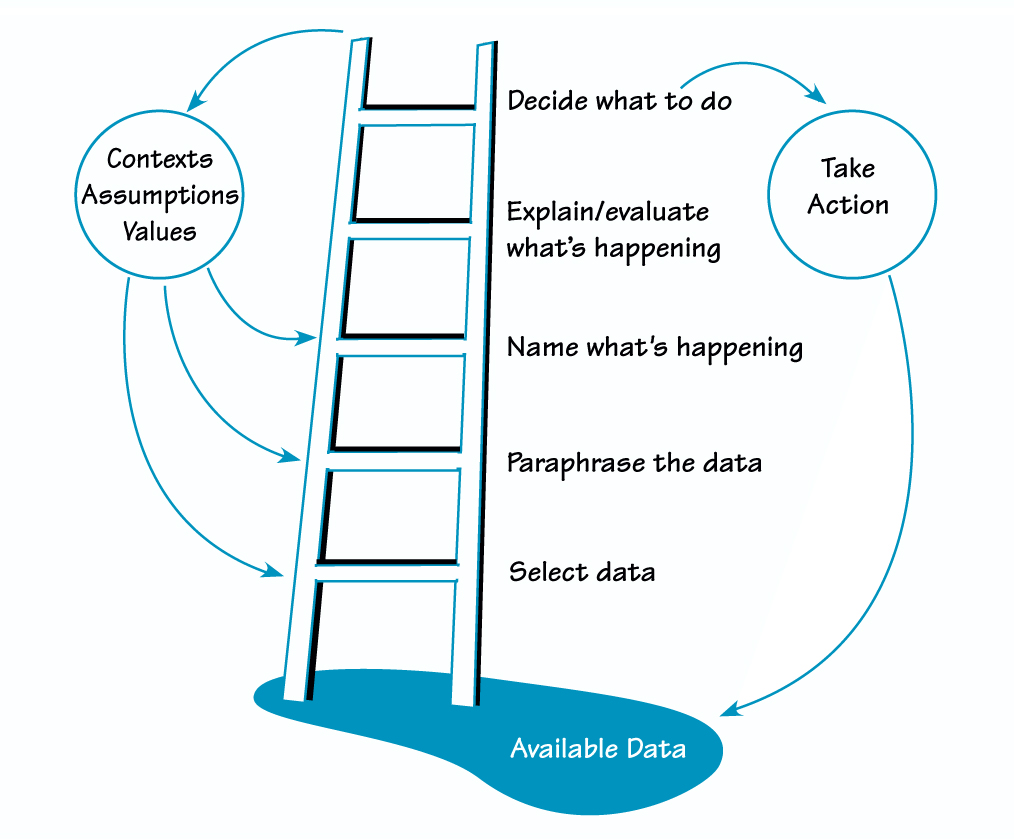How we act depends on how we understand the situation we are in. Our understandings often seem obvious to us, as if they were given by the situation itself. But people can come to very different understandings, depending on what aspects of the situation they notice and how they interpret what is going on. The Ladder of Inference is a model of the steps we use to make sense of situations in order to act. It helps us to think about our thinking and to coordinate our thinking with others.

Available Data: All the directly observable data that surround us in daily life, including people’s words, tone of voice, and body movement; statistical results from a marketing survey; accounting reports; and so on.
Example: Karen responds to your suggestion by pausing a moment and then saying, “That sounds like a rational approach.”
Select Data: Because we can’t pay attention to all available data, we sometimes make conscious choices about what data to select and what to ignore. More often, though, the selection process occurs subconsciously.
Example: You notice that Karen paused and then described the suggestion as “a rational approach.”
Paraphrase Data: When the data we select have to do with human interaction—including spoken language, written communication, and gesture—we next put into our own (unspoken) words what the person is saying or doing. This paraphrasing occurs as we listen and is fundamental to how we interpret the meaning of people’s actions.
Example: You say to yourself, “Karen is saying that there is a problem with my suggestion. While it is rational, it does not address the emotions involved.”
Name What Is Happening: The naming step continues the interpretation process by characterizing what is happening as belonging to a more general category.
Example: You characterize Karen’s actions as “Having doubts about my suggestion and covering them up.”
Explain/Evaluate What Is Happening: Having named what is happening, we then explain why it is happening by drawing on our stock of causal theories. We may also evaluate it as good or bad by drawing on our value system.
Example: You make the assessment that “Karen is uncomfortable with conflict and is politely preventing us from being of more help to her.”
Decide What to Do: Based on how we explain and/or evaluate what is happening, and drawing on our repertoire of actions, we decide what to do.
Example: You decide to stop offering suggestions.
Reflexive Loop: Our assumptions, values, and beliefs influence how we select data, interpret what is happening, and decide what to do. Our interpretations and decisions then feedback to reinforce (usually) our assumptions, values, and beliefs. We act on the basis of our interpretations, and our actions affect what data is available to us. So our ways of understanding and acting in the world create a self-reinforcing system, insulating us from alternative ways of understanding.
USING THE LADDER
The Impact of Jumping Up the Ladder
- Our own conclusions seem obviously right to us.
- People can and do reach different conclusions. When they each view their own conclusions as obvious, they don’t see a need to say how they reached them.
- People see the different conclusions of others as obviously wrong, and invent reasons to explain why others say things that are so obviously wrong.
- When people disagree, they often hurl conclusions at each other from the top of their respective ladders, making it hard to resolve differences and to learn from one another.
General Guidelines
- Notice your conclusions as conclusions based on your inferences, not as self-evident facts.
- Assume your reasoning process could have gaps or errors that you do not see.
- Use examples to illustrate the data you select that led to your conclusions.
- Paraphrase (out loud) the meanings you hear in what others say, so that you can check if you are understanding correctly.
- Explain the steps in your thinking that take you from the data you select and the meanings you paraphrase to the conclusions you reach.
- Ask others if they have other ways of interpreting the data or if they see gaps in your thinking.
- Assume that others may reach different conclusions because they have their own Ladder of Inference with a logic that makes sense to them.
- Ask others to illustrate the data they select and the meanings they paraphrase.
- Ask others to explain the steps in their thinking.
